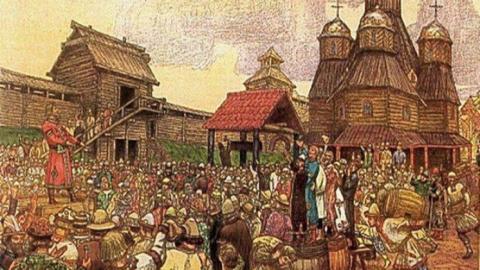THEATER OR BOOTH
Primary tabs

October 27 can be considered the date of the appearance of the theater in Russia. On this day in 1672, the first performance was staged in the Komedialnaya Khoromina, the first building in Russia, built specifically for theatrical performances near Moscow in Preobrazhensky by the decree of Tsar Alexei Mikhailovich. The actors were recruited from the Germans in the German Suburb. The play was in German.
It was based on a biblical story in the Lutheran interpretation. The name sounded like this:
“A comedy, as Artaserx ordered Haman to be hanged according to the tsarina’s petition and Mordechein’s teaching.”
The piece was directed by a Protestant preacher, the son of a pharmacist. The performance was in German.
The sight was unusual, long, and apparently disgusting. The first attempt to modernize Russian mores failed. And after the death of Alexei Mikhailovich, the Komedialnaya Khoromina was demolished as “godless” by the order of his more traditionalist-oriented son, Tsar Fyodor Alekseevich.
Later, they returned to theatrical performances – primarily in order to mock morality, piety, meaning, and good taste – already under Peter the Great. From now on, additional extremely scabrous elements were introduced into the theater, making everything that happened even more idiotic.
When we see what is happening with contemporary Russian theater, just such memories come to mind.
“A comedy, as Artaserx ordered to hang Haman according to the tsarina’s petition and Mordechein by teaching.” Theater in Russia began as something God-opposite and today it is moving in this direction.
And what about Stanislavsky? You ask. Yes, Stanislavsky is wonderful. But this is a theater inextricably linked with the culture of the Silver Age. His method comes to life only in a very specific context. To understand Stanislavsky, to stage the plays that he staged, and to continue his traditions, one cannot be a German from Slobodka, one cannot be a late-conscientious liberal degenerate. One must be the bearer of Russian culture and the Russian Logos, one must be well versed in Russian history and its semantics, one must be initiated into Russian culture. This dedication was the most important for all creators, poets, and actors of the Silver Age.
Stanislavsky’s method is a way of expressing the Russian mystery, conveying its meanings and its paradoxes, its dialectics, and its abysses. You cannot create a Russian theater and not be pierced by an irresistible love for Russia, a passion for Russia.
So it was in the era of the formation and flowering of the truly Russian theater. This also cast a glimpse into the Soviet period, when the traditions of the Silver Age were miraculously preserved despite the Marxist materialist gibberish. But gradually this spark began to fade, and in the last decades of the USSR, the theater again began to resemble “how Artaserx ordered to hang Haman” … and so on. And then everything collapsed.
In Russian culture, a theater is a theater of the Golden and Silver Ages. It arose exactly then, and only in their context makes sense.
But of course, the theater is something grandiose, cosmic. The depths of ancient drama were precisely thought about in the Silver Age, when Innokenty Annensky, Dmitry Merezhkovsky, Thaddeus Zelinsky, Vyacheslav Ivanov, and many other great poets and thinkers re-translated Aeschylus, Sophocles, and Euripides. These translations were the most important part for the comprehension of our Russian Mystery, served as its foundation, its life-giving source. At the same time, the Russians discovered Maeterlinck, Ibsen, Strindberg with their intense existential drama.
And it was in this tense context of the opening of the theater as such, the theater of the metaphysical, the theater of the sacred, the theater of the absolute, and Russian theatrical geniuses lived, created, and staged their performances. Their highest goal was to make the Russian theater a part of the great theater of the world, to unite in the theater and through the theater the fate of Russia and the tragedy of mankind.
Real theater requires incredible effort. All types of liberal arts converge in it – poetry, music, dance, painting, architecture, and most importantly philosophy, thought, spirit. The stupid theater is the most repulsive and humiliating perversion. In our history, alas, it began precisely with this. And again it is rapidly turning into the same thing.
The theater is more important than real life, as it sets its models, norms, horizons, and orientations, If a real theater can take place in Russia, it will change everything.
